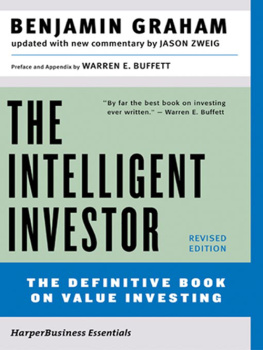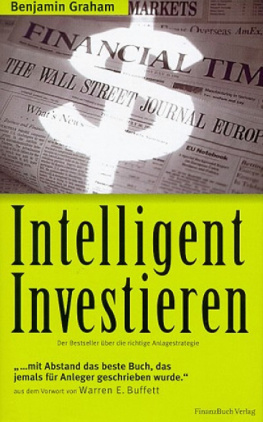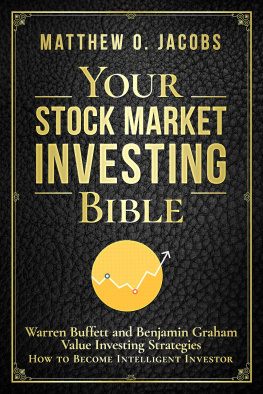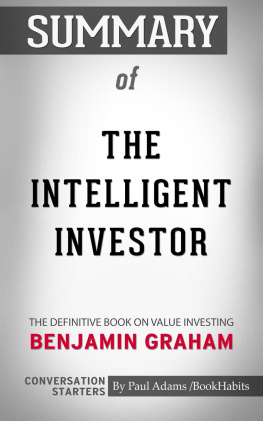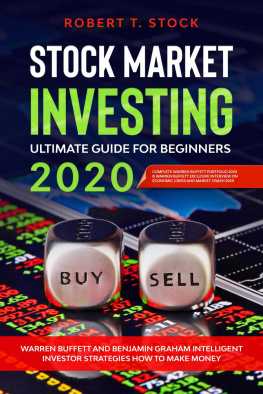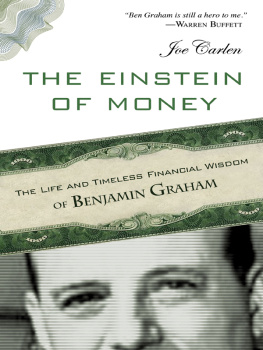To E.M.G.
Through chances various, through all
vicissitudes, we make our way.
Aeneid
Contents
The text reproduced here is the Fourth Revised Edition, updated by Graham in 1971-1972 and initially published in 1973. The numbered chapter notes are original to Grahambolded text in these notes is by Jason Zweig.
Jason Zweigs new notes within Grahams chapters are designated by an asterisk or a cross.
Preface to the Fourth Edition,
by Warren E. Buffett
I read the first edition of this book early in 1950, when I was nineteen. I thought then that it was by far the best book about investing ever written. I still think it is.
To invest successfully over a lifetime does not require a stratospheric IQ, unusual business insights, or inside information. Whats needed is a sound intellectual framework for making decisions and the ability to keep emotions from corroding that framework. This book precisely and clearly prescribes the proper framework. You must supply the emotional discipline.
If you follow the behavioral and business principles that Graham advocatesand if you pay special attention to the invaluable advice in Chapters 8 and 20you will not get a poor result from your investments. (That represents more of an accomplishment than you might think.) Whether you achieve outstanding results will depend on the effort and intellect you apply to your investments, as well as on the amplitudes of stock-market folly that prevail during your investing career. The sillier the markets behavior, the greater the opportunity for the business-like investor. Follow Graham and you will profit from folly rather than participate in it.
To me, Ben Graham was far more than an author or a teacher. More than any other man except my father, he influenced my life. Shortly after Bens death in 1976, I wrote the following short remembrance about him in the Financial Analysts Journal. As you read the book, I believe youll perceive some of the qualities I mentioned in this tribute.
Several years ago Ben Graham, then almost eighty, expressed to a friend the thought that he hoped every day to do something foolish, something creative and something generous.
The inclusion of that first whimsical goal reflected his knack for packaging ideas in a form that avoided any overtones of sermonizing or self-importance. Although his ideas were powerful, their delivery was unfailingly gentle.
Readers of this magazine need no elaboration of his achievements as measured by the standard of creativity. It is rare that the founder of a discipline does not find his work eclipsed in rather short order by successors. But over forty years after publication of the book that brought structure and logic to a disorderly and confused activity, it is difficult to think of possible candidates for even the runner-up position in the field of security analysis. In an area where much looks foolish within weeks or months after publication, Bens principles have remained soundtheir value often enhanced and better understood in the wake of financial storms that demolished flimsier intellectual structures. His counsel of soundness brought unfailing rewards to his followerseven to those with natural abilities inferior to more gifted practitioners who stumbled while following counsels of brilliance or fashion.
A remarkable aspect of Bens dominance of his professional field was that he achieved it without that narrowness of mental activity that concentrates all effort on a single end. It was, rather, the incidental by-product of an intellect whose breadth almost exceeded definition. Certainly I have never met anyone with a mind of similar scope. Virtually total recall, unending fascination with new knowledge, and an ability to recast it in a form applicable to seemingly unrelated problems made exposure to his thinking in any field a delight.
But his third imperativegenerositywas where he succeeded beyond all others. I knew Ben as my teacher, my employer, and my friend. In each relationshipjust as with all his students, employees, and friendsthere was an absolutely open-ended, no-scores-kept generosity of ideas, time, and spirit. If clarity of thinking was required, there was no better place to go. And if encouragement or counsel was needed, Ben was there.
Walter Lippmann spoke of men who plant trees that other men will sit under. Ben Graham was such a man.
Reprinted from the Financial Analysts Journal, November/December 1976.
W ho was Benjamin Graham, and why should you listen to him?
Graham was not only one of the best investors who ever lived; he was also the greatest practical investment thinker of all time. Before Graham, money managers behaved much like a medieval guild, guided largely by superstition, guesswork, and arcane rituals. Grahams Security Analysis was the textbook that transformed this musty circle into a modern profession.
And The Intelligent Investor is the first book ever to describe, for individual investors, the emotional framework and analytical tools that are essential to financial success. It remains the single best book on investing ever written for the general public. The Intelligent Investor was the first book I read when I joined Forbes Magazine as a cub reporter in 1987, and I was struck by Grahams certainty that, sooner or later, all bull markets must end badly. That October, U.S. stocks suffered their worst one-day crash in history, and I was hooked. (Today, after the wild bull market of the late 1990s and the brutal bear market that began in early 2000, The Intelligent Investor reads more prophetically than ever.)
Graham came by his insights the hard way: by feeling firsthand the anguish of financial loss and by studying for decades the history and psychology of the markets. He was born Benjamin Grossbaum on May 9, 1894, in London; his father was a dealer in china dishes and figurines. The family moved to New York when Ben was a year old. At first they lived the good lifewith a maid, a cook, and a French governesson upper Fifth Avenue. But Bens father died in 1903, the porcelain business faltered, and the family slid haltingly into poverty. Bens mother turned their home into a boardinghouse; then, borrowing money to trade stocks on margin, she was wiped out in the crash of 1907. For the rest of his life, Ben would recall the humiliation of cashing a check for his mother and hearing the bank teller ask, Is Dorothy Grossbaum good for five dollars?
Fortunately, Graham won a scholarship at Columbia, where his brilliance burst into full flower. He graduated in 1914, second in his class. Before the end of Grahams final semester, three departmentsEnglish, philosophy, and mathematicsasked him to join the faculty. He was all of 20 years old.
Instead of academia, Graham decided to give Wall Street a shot. He started as a clerk at a bond-trading firm, soon became an analyst, then a partner, and before long was running his own investment partnership.
The Internet boom and bust would not have surprised Graham. In April 1919, he earned a 250% return on the first day of trading for Savold Tire, a new offering in the booming automotive business; by October, the company had been exposed as a fraud and the stock was worthless.
Graham became a master at researching stocks in microscopic, almost molecular, detail. In 1925, plowing through the obscure reports filed by oil pipelines with the U.S. Interstate Commerce Commission, he learned that Northern Pipe Line Co.then trading at $65 per shareheld at least $80 per share in high-quality bonds. (He bought the stock, pestered its managers into raising the dividend, and came away with $110 per share three years later.)
Despite a harrowing loss of nearly 70% during the Great Crash of 19291932, Graham survived and thrived in its aftermath, harvesting bargains from the wreckage of the bull market. There is no exact record of Grahams earliest returns, but from 1936 until he retired in 1956, his Graham-Newman Corp. gained at least 14.7% annually, versus 12.2% for the stock market as a wholeone of the best long-term track records on Wall Street history.

